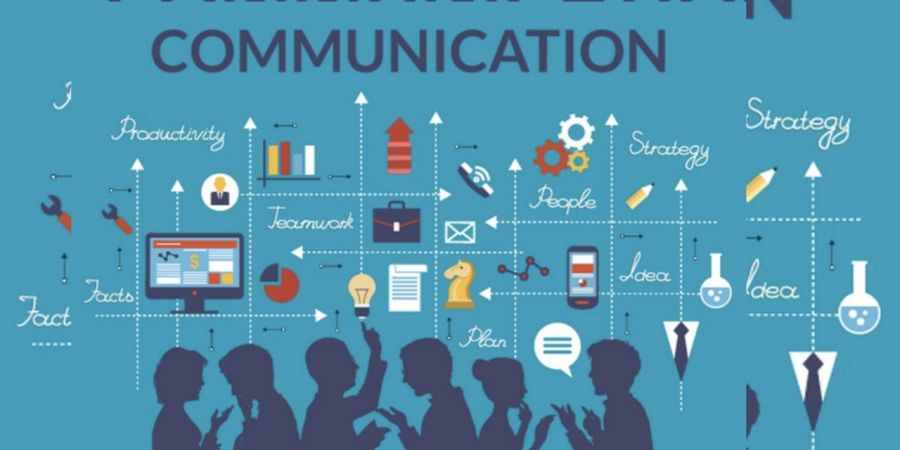

#Verbal communication occurs when we engage in speaking with others. It can be face-to-face, over the telephone, via Skype or Zoom, etc. Some verbal engagements are informal, such as chatting with a friend over coffee or in the office kitchen, while others are more formal, such as a scheduled meeting. Regardless of the type, it is not just about the words, it is also about the caliber and complexity of those words, how we string those words together to create an overarching message, as well as the intonation (pitch, tone, cadence, etc.) used while speaking. And when occurring face-to-face, while the words are important, they cannot be separated from non-verbal communication.
What we do while we speak often says more than the actual words. #Non-verbal communication includes facial expressions, posture, eye contact, hand movements, and touch. For example, if you’re engaged in a conversation with your boss about your cost-saving idea, it is important to pay attention to both the their words and their non-verbal communication. Your boss might be in agreement with your idea verbally, but their nonverbal cues: avoiding eye contact, sighing, scrunched up face, etc. indicate something different.
Whether it is an email, a memo, a report, a Facebook post, a Tweet, a contract, etc. all forms of #written communication have the same goal to disseminate information in a clear and concise manner – though that objective is often not achieved. In fact, poor writing skills often lead to confusion and embarrassment, and even potential legal jeopardy. One important thing to remember about written communication, especially in the digital age, is the message lives on, perhaps in perpetuity. Thus, there are two things to remember: first, write well – poorly constructed sentences and careless errors make you look bad; and second, ensure the content of the message is something you want to promote or be associated with for the long haul.
The act of listening does not often make its way onto the list of types of communication. Active listening, however, is perhaps one of the most important types of communication because if we cannot listen to the person sitting across from us, we cannot effectively engage with them. Think about a negotiation – part of the process is to assess what the opposition wants and needs. Without listening, it is impossible to assess that, which makes it difficult to achieve a win/win outcome.
We are a visual society. Think about it, televisions are running 24/7, Facebook is visual with memes, videos, images, etc., Instagram is an image-only platform, and advertisers use imagery to sell products and ideas. Think about from a personal perspective – the images we post on social media are meant to convey meaning – to communicate a message. In some cases that message might be, look at me, I’m in Italy or I just won an award. Others are carefully curated to tug on our heartstrings – injured animals, crying children, etc.
Verbal communications in business take place over the phone or in person. The medium of the Message is oral. Let’s return to our printer cartridge example. This time, the Message is being conveyed from the Sender (the Manager) to the Receiver (an employee named Bill) by telephone. We’ve already seen how the Manager’s request to Bill (“We need to buy more printer toner cartridges”) can go awry. Now let’s look at how the same Message can travel successfully from Sender to Receiver.
Manager (speaking on the phone): “Good morning, Bill!”
(By using the employee’s name, the manager is establishing a clear, personal link to the Receiver.)
Manager: “Your division’s numbers are looking great.”
(The Manager’s recognition of Bill’s role in a winning team further personalizes and emotionalizes the conversation.)
Manager: “Our next step is to order more printer toner cartridges. Could you place an order for 1,000 printer toner cartridges with Jones Computer Supplies? Our budget for this purchase is $30,000, and the cartridges need to be here by Wednesday afternoon.”
(The Manager breaks down the task into several steps. Each step consists of a specific task, time frame, quantity, or goal.)
Bill: “Sure thing! I’ll call Jones Computer Supplies and order 1,000 more printer toner cartridges, not exceeding a total of $30,000, to be here by Wednesday afternoon.”
(Bill, who is good at active listening, repeats what he has heard. This is the Feedback portion of the communication, and verbal communication has the advantage of offering opportunities for immediate feedback. Feedback helps Bill to recognize any confusion he may have had hearing the manager’s Message. Feedback also helps the manager to tell whether she has communicated the Message correctly.)
Storytelling has been shown to be an effective form of verbal communication; it serves an important organizational function by helping to construct common meanings for individuals within the organization. Stories can help clarify key values and help demonstrate how things are done within an organization, and story frequency, strength, and tone are related to higher organizational commitment (McCarthy, 2008). The quality of the stories entrepreneurs tell is related to their ability to secure capital for their firms(Martens, et. al., 2007). Stories can serve to reinforce and perpetuate an organization’s culture, part of the organizing P-O-L-C function.
While the process may be the same, high-stakes communications require more planning, reflection, and skill than normal day-to-day interactions at work. Examples of high-stakes communication events include asking for a raise or presenting a business plan to a venture capitalist. In addition to these events, there are also many times in our professional lives when we have crucial conversations—discussions where not only the stakes are high but also where opinions vary and emotions run strong (Patterson, et. al., 2002). One of the most consistent recommendations from communications experts is to work toward using “and” instead of “but” as you communicate under these circumstances. In addition, be aware of your communication style and practice flexibility; it is under stressful situations that communication styles can become the most rigid.
In contrast to verbal communications, written business communications are printed messages. Examples of written communications include memos, proposals, e-mails, letters, training manuals, and operating policies. They may be printed on paper, handwritten, or appear on the screen. Normally, a verbal communication takes place in real time. Written communication, by contrast, can be constructed over a longer period of time. Written communication is often asynchronous (occurring at different times). That is, the Sender can write a Message that the Receiver can read at any time, unlike a conversation that is carried on in real time. A written communication can also be read by many people (such as all employees in a department or all customers). It’s a “one-to-many” communication, as opposed to a one-to-one verbal conversation. There are exceptions, of course: a voicemail is an oral Message that is asynchronous. Conference calls and speeches are oral one-to-many communications, and e-mails may have only one recipient or many.
Figure 12.14

Communication mediums have come a long way since Alexander Graham Bell’s original telephone.
Wikimedia Commons – First Bell telephone 1875 – public domain.
Most jobs involve some degree of writing. According to the National Commission on Writing, 67% of salaried employees in large American companies and professional state employees have some writing responsibility. Half of responding companies reported that they take writing into consideration when hiring professional employees, and 91% always take writing into account when hiring (for any position, not just professional-level ones) (Flink, 2007).
Luckily, it is possible to learn to write clearly. Here are some tips on writing well. Thomas Jefferson summed up the rules of writing well with this idea “Don’t use two words when one will do.” One of the oldest myths in business is that writing more will make us sound more important; in fact, the opposite is true. Leaders who can communicate simply and clearly project a stronger image than those who write a lot but say nothing.
What you say is a vital part of any communication. But what you don’t say can be even more important. Research also shows that 55% of in-person communication comes from nonverbal cues like facial expressions, body stance, and tone of voice. According to one study, only 7% of a Receiver’s comprehension of a Message is based on the Sender’s actual words; 38% is based on paralanguage (the tone, pace, and volume of speech), and 55% is based on nonverbal cues (body language) (Mehrabian, 1981).
Research shows that nonverbal cues can also affect whether you get a job offer. Judges examining videotapes of actual applicants were able to assess the social skills of job candidates with the sound turned off. They watched the rate of gesturing, time spent talking, and formality of dress to determine which candidates would be the most successful socially on the job (Gifford, et. al., 1985). For this reason, it is important to consider how we appear in business as well as what we say. The muscles of our faces convey our emotions. We can send a silent message without saying a word. A change in facial expression can change our emotional state. Before an interview, for example, if we focus on feeling confident, our face will convey that confidence to an interviewer. Adopting a smile (even if we’re feeling stressed) can reduce the body’s stress levels.
To be effective communicators, we need to align our body language, appearance, and tone with the words we’re trying to convey. Research shows that when individuals are lying, they are more likely to blink more frequently, shift their weight, and shrug (Siegman, 1985
